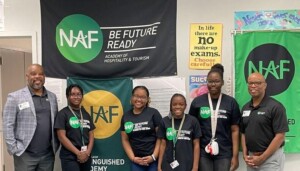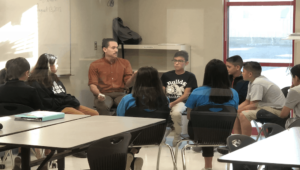Next-Gen Advisory For Dropout Prevention

As we continue to share ideas and resources for Dropout Prevention Month, sharing the importance of strong advisory programs that help students stay on track came to mind.
We know that often, students who decide to drop out do so because they feel disconnected from school and their peers. Advisory programs help students stay engaged in their learning process, develop agency and create a personalized plan for their education that will keep them in school and on the path to college, career and life success.
As Tom shares in the blog below, the most successful high schools he has seen on his visits around the country have a strong student advisory structure in place. Here are 10 functions he sees as the foundation of next-gen advisory.
By Tom Vander Ark
College and career readiness mean a lot more than passing a community college entrance exam (although that is the minimum bar for all kids). It also requires a set of deeper learning experiences that result in the knowledge, skills and dispositions young people will need to succeed (for more see David Conley’s book, Getting Ready for College, Careers, and the Common Core: What Every Educator Needs to Know ).
In many high schools, the shuffle of a discipline-based, big-catalog master schedule can lead to a lack of sustained relationships and opportunities for students to fall through the cracks. Important outcomes get little attention with the lack of an advisory spine.
All of the great high schools that I visit have a strong distributed counseling system and advisory structure–a souped-up homeroom that promotes a sustained relationship with an advisor, academic monitoring and management and links to services.
Ted Sizer and the Coalition of Essential Schools spread the advisory gospel in the 80s and 90s. Because it was largely a manual labor of love, advisories varied in structures, function and effectiveness.
The toolset for college awareness, preparation, application and aid are slowly getting better. Next-generation advisory will combine daily (or at least three times per week) meetings with desktop apps that surface data from a variety of sources to provide real-time guidance, and will fulfill or coordinate 10 functions:
1. Academic monitoring. Next-gen platforms (e.g., EAA Buzz and Summit Activate) surface daily progress reports facilitating timely conversations between advisors and students.
2. Homework help. The advisory period can be a place to connect with a little extra help, including online support (e.g., Tutor.com, Brainly).
3. Developing self-direction. Author James Davison Hunter said character is:
- The self-restraint to say no;
- Making affirmations of ideas bigger than self; and
- Making a choice.
Character development and habits of self-management can be discussed in advisory and reinforced with curriculum and productivity apps (e.g., Remember The Milk).
4. Academic mindset and culture. Launch Expeditionary Learning Charter School starts the day with Crew, a 30-minute advisory period where they practice and talk about the shared Habits of Heart and Mind central to the Launch culture: accountability, craftsmanship, wonder, mindfulness, and compassion.
5. Social & emotional learning. Summit Public Schools encourage habits of success based on the CASEL framework.
6. College awareness & application. Good schools build college talk into their culture and arrange lots of college visits–at IDEA Public Schools students visit 15-20 colleges. Upper division advisories coordinate the college application process using resources including College Board Big Future, Naviance, Chegg. Groups like Strive for College use mentors and data to help students make the best possible post-secondary choice.
7. Transcript management and course selection. With the growth of online course choice (read more about Guthrie Common School District in Texas) helping students build a thoughtful pathway and transcript is of growing importance.
8. Career awareness. New tools are helping to boost awareness of career options (e.g., Mytonomy, Mapping Your Future). Networks like Cristo Rey use an advisory period to prepare students for work-study.
9. Counseling. In a distributed counseling model, advisors are often the first to spot potential problems, provide first line support, and refer students to a school counselor.
10. Connection to youth and family services. When advisors identify student or families needs, they can make referrals to a web of community support groups through a partner like Communities in Schools.
These 10 functions make up the spine of a next-gen secondary school. There is some overlap on this list so the agreed upon functions at your school may only be a half a dozen functions. These functions are important enough to warrant time every day, staff development, strong coordination, an adopted curriculum and personalizing tools.
A version of this blog originally ran here.
For more, see:
- The Roll of Advisory in Personalizing the Secondary Experience
- 15 Dimensions of Personalized Learning
- How to Promote College Readiness: A Washington State Case Study
Stay in-the-know with all things EdTech and innovations in learning by signing up to receive the weekly Smart Update.





0 Comments
Leave a Comment
Your email address will not be published. All fields are required.